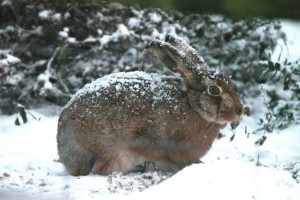 One of the problems with looking at wild animals in the Highlands is that most of them, in a variety of ways, are secretive and difficult to watch. Some animals, such as the fox, badger and pine marten, are nocturnal whilst others such as the rabbit and brown hare rely on their camouflage. Some, such as roe deer and sika deer, rely on cover such as woodland. The sika deer takes this to a fine art in that both the stags and hinds will stand motionless amongst the trees even when you are quite close. Their camouflage in such conditions are ideal and often you do not know they are even there. I recall when the only thing that gave a stag away that was watching me was a pair of great tits. The stag was in dense woodland and I sensed something was there and, seeing a slight movement, I looked through binoculars. There was a pair of great its running up and down the stag’s antlers looking for insects and then I saw the head of the stag. Otherwise I would never have known it was there. In contrast red deer will rely on the extent of open moorland so that it can see you from afar and run off.
One of the problems with looking at wild animals in the Highlands is that most of them, in a variety of ways, are secretive and difficult to watch. Some animals, such as the fox, badger and pine marten, are nocturnal whilst others such as the rabbit and brown hare rely on their camouflage. Some, such as roe deer and sika deer, rely on cover such as woodland. The sika deer takes this to a fine art in that both the stags and hinds will stand motionless amongst the trees even when you are quite close. Their camouflage in such conditions are ideal and often you do not know they are even there. I recall when the only thing that gave a stag away that was watching me was a pair of great tits. The stag was in dense woodland and I sensed something was there and, seeing a slight movement, I looked through binoculars. There was a pair of great its running up and down the stag’s antlers looking for insects and then I saw the head of the stag. Otherwise I would never have known it was there. In contrast red deer will rely on the extent of open moorland so that it can see you from afar and run off.
If you cannot see your animal then the next best thing is to look for signs of them. Animals such as red squirrels and mice will leave tell tale pine cones and the way they deal with them can give the species away. Hazel nuts are also tackled by squirrels and mice and here again the tell tale signs can be a give-away to which animal has done the damage to get inside. Some animals, such as brown hares, foxes and badgers, will leave tell-tale hairs on fences where they have squeezed through. Droppings are also a good way of indicating which animals have been around. Some animals such as otters deliberately leave such droppings to indicate to other otters, both dog and bitch, that the territory is occupied.
However, with the snow falls at low levels starting, this is the best time of the year to look for tracks. The only problem is that the amount of snowfall must be right and at the right time. Ideally around two inches is the best, certainly no more, as if it is deeper then the tracks are difficult to identify as they are not clear. As for the time of the day the ideal is a snowfall just before it gets dark and then no more snow overnight. This means that any animals on the move during the hours of darkness, or at first light, will be leaving tracks.
Whilst there may be very many tracks around, identification is still a problem although some are much easier than others. For example, the two that are the easiest to identify are the fox and the brown hare. Most of the tracks of a fox are in a straight line as if the aim is to deliberaterly put one paw in front of another. The brown hare has a very unusual gait in that the forelegs are placed on the ground and the rear legs are brought forward either side and in front of the so called front paws This combinations is very unusual in that it shows up quite clearly in the deepest of snow. The best book for identifying tracks in snow, and for a range of other tracks and signs, is “Animal Tracks and Signs” by Preben Bang and Preben Dahlstrom”, published by Oxford University Press. Good tracking!
Tags: highland wildlife
